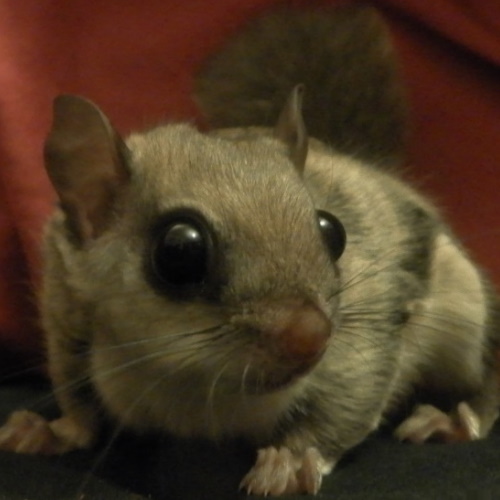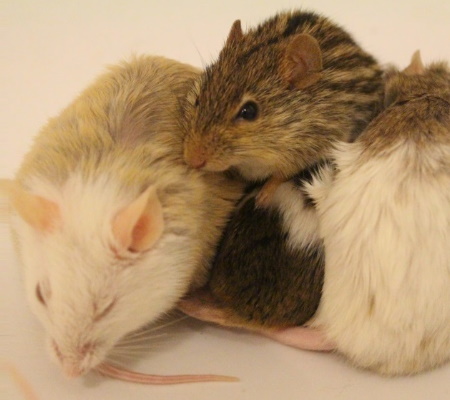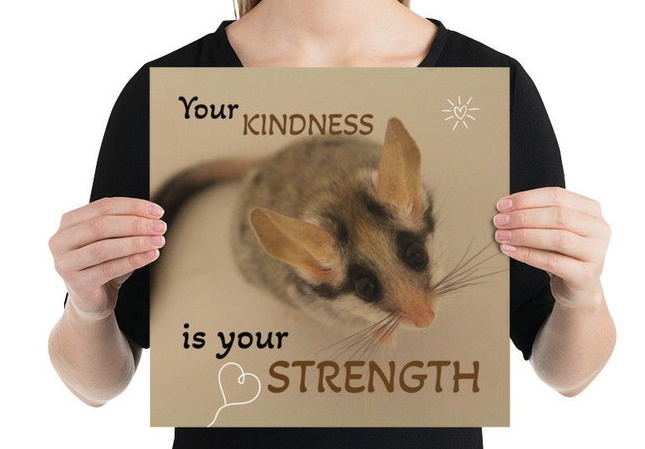Cohabiting different species of Mice
Author: Christine, of Crittery Exotics
This article discusses a successful example of three mouse species cohabiting after a lonely Zebra Mouse was evicted from a family group.
Cohabiting different species is rarely recommended. However, sometimes you are left in a situation where you have a lone animal that cannot be paired up with another of its own kind without neutering or a lengthy splitcage (with low success rates).
Combinations such as hamsters/mice for instance should never be undertaken. Hamsters have a fascination with mouse tails and may chew the entire length of a mouse tail off. Dietary differences should also be considered and the fact that company of another species, will never fully substitute for that of their own kind.
Linus, an adult male Zebra Mouse was left alone following a family fallout. Although he had always been quite happy being handled he was becoming quite withdrawn on his own. Having been offered some Multimammate mice from an unexpected litter, I decided to try adding these as company for him since the recovery time after neutering would have meant his family group forgot him and he would have needed to be introduced with a splitcage anyway.
Multimammate mice and fancy mice are often mixed to provide company for a lone fancy mouse male without the risk of breeding. Although male mice can be neutered and then have a harem of girls after 6 weeks, the operation is obviously not without risk. Following good advice, I chose two multimammate girls to mix with Linus, as then they still had company of their own kind (which is always the preferred option) which would be especially important if the introduction with Linus failed.
I followed the normal process for Fancy Mice Introductions and introduced on neutral territory. Some initial, fairly disinterested sniffing occurred. I monitored and then added food and water - using a large shallow bowl with space for all three. Had there been any signs such as chasing, squeaking, or even dominance mounting I would have scatter fed.
After a few hours I transferred them to their main perfecto tank but left it very sparse - with no toys to fight over and only cardboard tubes and over chewable material. Linus and the two girls showed very little interest in each other and slept apart for the first few days. After this, we did witness Linus grooming the larger of the Multimammate girls and they do sometimes sleep together. They show no evidence of dominance mounting, any signs of aggression or fighting over toys.
Adding a Fancy Mouse
This wasn't planned, but I do like to be aware of the rodents needing homes, especially in my local area. I saw a male ginger fancy mouse being offered free to a good home barely 10 miles away and within a few days, was bringing him home. Rodents should never be offered free, due to the risk of them ending up as cheap snake food. One option is to ask for a small donation to charity should you not feel comfortable taking money in yourself.
Charlie proved to be a calm, quite overweight ginger mouse. Red mice are prone to obesity more than others, although he had been on a diet of hamster food which hadn't helped. Although he had clearly been well loved, the one aspect he was missing was company!
After a night to settle in and get used to the sounds of our house I introduced Charlie to Linus and the girls during an afternoon I had off from work. Akin to the earlier stage, there was absolutely zero signs of aggression.
Slightly different to Linus, was that Charlie instantly showed more interest in the other mice and within minutes was grooming all of them. They all submitted themselves to this quite happily. I introduced new food and water bowls which they all then shared happily.
After a few hours in the sparse introduction tank, I moved them back to the perfecto - with wheel, tubes and tunnels. Normally I would only offer cardboard that can easily be destroyed but I gave these guys wooden and cork tubes and they settled in nicely.
Conclusion
Multimammate mice are known for their easily adaptability to fancy mice and it seems this does extend to other species as well. If I were to extrapolate from this example, I would say that Fancy mice and Multimammates do gain more from each others' company than Zebra mice/Multimammate or Zebra Mice/Fancy Mice however I would add that since the introduction of Charlie I have noticed an increase in the frequency of Linus joining the sleeping mouse pile so I think this addition has improved the social dynamic.
Since both intact fancy and intact zebra mice males are not easy to introduce together or keep happily together it seems unlikely I will be adding to this clan, however it is nice to note that should a neutered male of either species pop up in rescue in the future that I may be able to expand their cage size and add an extra addition.
I hope this account is useful to those of you out there that may not have an option to add same species. I'm well aware that I am not going to be the first who has discovered this, however since I had not found a writeup of this I felt it would be helpful to share. Thank you for reading.

Christine
Christine runs Crittery Exotics and is an experienced animal keeper & content writer.
About Crittery

